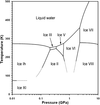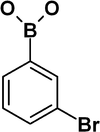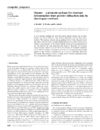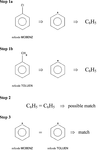issue contents
August 2005 issue

Cover illustration: Secondary electron image of a crystalline iron ore sinter phase, produced by heating to 1533 K and then cooling. Courtesy of N. V. Y. Scarlett, I. C. Madsen, M. I. Pownceby & A. N. Christensen [J. Appl. Cryst. (2004), 37, 362-368].
research papers
Open  access
access
 access
accessA simple pressure cell for single-crystal X-ray crystallography at pressures up to 1 kbar (105 kPa) has been developed. A special attachment for mounting the cell onto a goniometer and a new data collection procedure are described.
A whole-pattern fitting of X-ray diffraction patterns, including lattice-parameter and size–strain analysis, was elaborated and applied to a sample set of extant and fossil vertebrate tooth apatite.
Theoretical modelling of X-ray guided modes excited by means of Bragg reflections of periodical multilayer structures has been implemented. Analytical expressions describing the resonant X-ray intensity enhancement inside a guiding layer have been found.
R factors are used to check the reliability of orientation distribution function (ODF) refinement by the iterative WIMV method on real samples. These values are compared with those obtained on synthetic standard data. Two criteria are given to help when comparing the reliability of refinements of ODFs.
Open  access
access
 access
accessThe incompressibility and thermal expansivity of D2O ice II determined by powder neutron diffraction
Time-of-flight powder neutron diffraction has been used to determine the thermoelastic properties of D2O ice II.
Structure development in aerogel-processed nanocrystalline alkaline earth oxides as revealed by SANS
Small-angle neutron scattering (SANS) experiments were conducted on a series of nanocrystalline alkaline earth oxide powders and their precursors in order to characterize structural development in this system. Results show the effect of cation size on the characteristic structural features of each material and the changes that occur during supercritical versus subcritical drying and subsequent calcination.
Download citation


Download citation


Micro-powder X-ray diffraction patterns of two compounds, namely 3-bromophenylboronic acid and tris(4-bromophenyl)boroxine, were recorded with microgram quantities of sample using a recently developed method employing nylon loops with synchrotron radiation and an image-plate detector. This method, besides using small amount of samples, offers the advantage of recording the powder pattern in the shortest possible time (less than a minute).
Full three-dimensional diffuse neutron scattering data have been recorded from a single crystal of Pb(Zn1/3Nb2/3)O3 (PZN) using the time-of-flight Laue technique on the SXD single-crystal instrument at ISIS. The data have been interpreted using Monte Carlo simulation in terms of a model that has as its basis the fact that Pb2+ possesses a lone pair of electrons.
The sensitivity of atomic scattering factors to valence charge distributions has been compared quantitatively for X-ray and electron diffraction. The work reveals the importance of accurate determination of a very few low-order structure factors in valence electron density studies, and suggests the merit of the combined use of electron diffraction and density functional theory calculations for solids, especially those with large unit cells and nanocrystalline grains, unsuitable for X-ray studies.
Surface morphology of {100} faces of LAP crystals was investigated by atomic force microscopy (AFM). Both the steps and the two-dimensional nuclei elongate along the b direction, which is determined by the crystal structure.
Open  access
access
 access
accessIn order to establish an accurate quadratic channel-to-energy conversion function, a Matlab program was written to find the best quadratic coefficient and hence the whole energy conversion function. This energy conversion function was used to perform a whole-pattern fitting of the energy-dispersive X-ray diffraction pattern of a Ti64 sample.
The stored energy of warm-rolled interstitial-free steels, produced in an accumulative roll bonding process, is evaluated by using the textural and microstructural information contained in orientation imaging microscopy scans which were measured after accumulated von Mises strains (∊vM) of 0.8, 1.6, 2.4 and 4.0, respectively.
High-quality CePO4 single crystals (monazite) were grown by the flux TSSG (top-seeded-solution growth) slow-cooling method. Growth habits were deduced by the Bravais–Friedel Donnay–Harker (BFDH) method and macro-defects in the crystals are discussed.
A method for lattice-plane distance determination, similar to Bond's method but not requiring a special goniometer, is presented. Its use in single-crystal stress measurement is demonstrated.
short communications
A new procedure aimed at disentangling the instrumental profile broadening and the relevant X-ray powder diffraction profile shape is presented.
computer programs
Organa, for ab initio solution of crystal structures from powder diffraction data, is based on a global minimization of the R factor combined with a potential energy function. For global minimization, energy-guiding Monte Carlo and grid-search algorithms are available, all with the option of local minimization of the cost function.
A computer program to search the Cambridge Structural Database for pairs of entries in which one functional group has been replaced by another is described.
Crystallographic tools operating on crystal structure database entries enable experimentalists to prepare complex atomic models and input data files for running ab initio software, and to interpret their output files. Applications include elastic tensors, clusters, nanotubes, surfaces, adsorption, epitaxy, multilayer systems, catalysis, hydrogen storage, batteries etc.
computer program abstracts
A Linux live-CD distribution containing a collection of scientific software, including Rietveld software and a crystallographic software development environment, is decribed.
crystallographers
Free 



 journal menu
journal menu








































